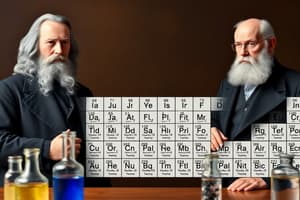Podcast
Questions and Answers
What is the periodic table?
What is the periodic table?
- A chart showing chemical reactions
- The way in which the elements are organized and classified (correct)
- A list of all known compounds
- A graph of atomic weights
Who proposed one of the first periodic tables?
Who proposed one of the first periodic tables?
John Dalton
Who arranged the elements into sets of eight based on similar properties?
Who arranged the elements into sets of eight based on similar properties?
John Newlands
Which chemist proposed the periodic table we use today?
Which chemist proposed the periodic table we use today?
What does the atomic number of an element define?
What does the atomic number of an element define?
What is a group in the periodic table?
What is a group in the periodic table?
What is a period in the periodic table?
What is a period in the periodic table?
Where are metals located in the periodic table?
Where are metals located in the periodic table?
Where are non-metals found in the periodic table?
Where are non-metals found in the periodic table?
What are noble gases?
What are noble gases?
What characterizes alkali metals?
What characterizes alkali metals?
How does reactivity trend down the alkali metals group?
How does reactivity trend down the alkali metals group?
What happens to the reactivity of halogens as you go down the group?
What happens to the reactivity of halogens as you go down the group?
Metal atoms tend to _____ electrons.
Metal atoms tend to _____ electrons.
Non-metals tend to _____ electrons.
Non-metals tend to _____ electrons.
What are the two products formed when an alkali metal reacts with water?
What are the two products formed when an alkali metal reacts with water?
Describe the reaction of lithium with water.
Describe the reaction of lithium with water.
What happens when sodium reacts with water?
What happens when sodium reacts with water?
Describe the reaction of potassium with water.
Describe the reaction of potassium with water.
What effect does size have on the reactivity of alkali metals?
What effect does size have on the reactivity of alkali metals?
What is a displacement reaction?
What is a displacement reaction?
Flashcards are hidden until you start studying
Study Notes
The Periodic Table
- Organized classification of elements based on regularly repeating patterns.
Key Scientists
- John Dalton: Proposed an early periodic table based on atomic weight.
- John Newlands: Arranged elements into sets of eight, noting similarities every eighth element.
- Dmitri Mendeleev: Developed the modern periodic table, leaving gaps for undiscovered elements; widely accepted in the scientific community.
Element Classification
- Atomic Number: Number of protons in an element, determining its position in the periodic table.
- Groups: Vertical columns; group number indicates the number of outer shell electrons.
- Periods: Horizontal rows across the periodic table.
Types of Elements
- Metals: Found on the left of the table; good electrical conductors.
- Non-metals: Located in the upper right corner; act as electrical insulators.
- Noble Gases: Located in Group 0; known for their unreactivity due to full outer electron shells.
- Alkali Metals: Group 1; characterized by increasing melting/boiling points down the group, vigorous reactions with water, and increasing reactivity from lithium to potassium.
- Halogens: Group 7; exhibit decreasing reactivity down the group, form negative ions, and covalent bonds with non-metals.
- Transition Metals: Central block of metals; higher melting points and densities than alkali metals, less reactive, and act as important industrial catalysts.
Reactivity Trends
- Alkali Metals: Reactivity increases down the group as outer electrons are further from the nucleus, making them easier to remove.
- Halogens: Reactivity decreases down the group due to increased shielding of the nucleus, weakening its ability to attract electrons.
Chemical Reactions
- Alkali metal + water produces metal hydroxide and hydrogen gas.
- Lithium reacts by floating and fizzing slowly until disappearance.
- Sodium forms a ball, fizzes rapidly, and may ignite with an orange flame.
- Potassium fizzes rapidly, ignites with a purple flame, sometimes producing a 'pop' sound.
Additional Information
- Displacement Reaction: More reactive halogen replaces a less reactive one.
- Metal Atoms: Tend to lose electrons.
- Non-metals: Tend to gain electrons.
Studying That Suits You
Use AI to generate personalized quizzes and flashcards to suit your learning preferences.




